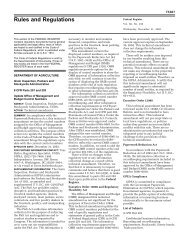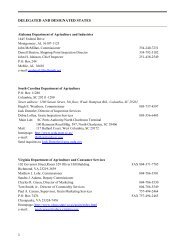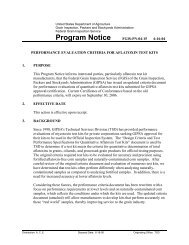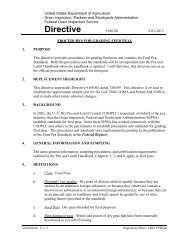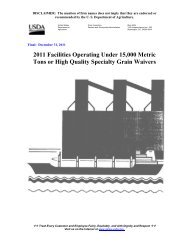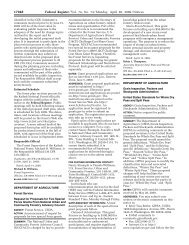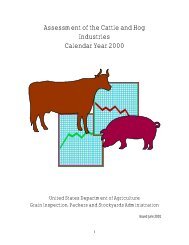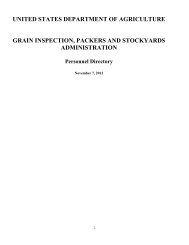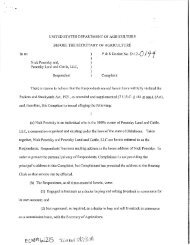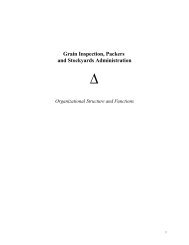GENERAL
GENERAL
GENERAL
Create successful ePaper yourself
Turn your PDF publications into a flip-book with our unique Google optimized e-Paper software.
<strong>GENERAL</strong><br />
1. Can the special grade infested be added to or removed during a reinspection/appeal (basis file<br />
sample), or Board appeal when the original sample was based on a probed sample?<br />
ANSWER. If the sample is made infested during the original inspection, the infested designation<br />
cannot be eliminated on a worked or unworked file sample. If, however, the infested designation<br />
is not applied during the original inspection, the infested designation may be added during the<br />
review inspection process provided sufficient numbers are present in the file sample.<br />
NOTE: If the reinspection or appeal is based on a new sample, the infested designation can be<br />
added or taken away depending on the number of insects found in the new sample.<br />
2. Can the special grade infested be added or taken away on the reinspection, appeal, or Board<br />
appeal when the original sample was based on a diverter sample and examined under<br />
continuous loading?<br />
ANSWER. The reinspection, appeal, and Board appeal result will follow the original result unless<br />
it can be determined that the sampler made a material error at the time of sampling.<br />
NOTE: For land carriers and barges an applicant may request that a probe sample be obtained<br />
as part of the reinspection or appeal, and examined for condition factors (i.e., musty, sour,<br />
heating, infested) only. The review inspection certificate will continue to show the D/T as the<br />
"method of sampling" in the sampling block of the certificate. The D/T file sample will be used to<br />
determine the factor information and the probe sample to review the condition in question.<br />
When a probed sample is used for condition, use the approved statement listed in Book IV (Pages<br />
3‐18 or 3‐20). This option does not apply to multiple grade inspection lots.<br />
3. Can an applicant request a reinspection, appeal, or Board appeal on a worked file sample for<br />
objective factors, such as test weight, moisture, broken corn and foreign material, or dockage<br />
when there is not a virgin portion to analyze?<br />
ANSWER. An applicant always has the right to request a review inspection, but the applicant<br />
should be made aware that the review inspection will not be based on a new portion, the results<br />
will be carried over from the preceding inspection if there was not a material error.<br />
4.<br />
5. What is the standardized work portion for the grains under the United States Grain<br />
Standards Act (USGSA)?<br />
ANSWER. The standardized portion for all grains should range from 1 1/8 to 1 1/4 quarts. When<br />
converted to grams the normal range would be the following:<br />
GRAIN RANGE GRAIN RANGE<br />
Barley 850‐950 Rye 1000‐1050<br />
Canola 500 Sorghum 1000‐1050<br />
Corn 1000‐1050 Soybeans 1000‐1050<br />
Flaxseed 1000‐1050 Sunflower Seed 500‐600<br />
Mixed Grain Depends on Mixture Triticale 1000‐1050<br />
Oats 700‐750 Wheat 1000‐1050
5. What are the DKT portion size tolerances for the grains under the USGSA?<br />
ANSWER:<br />
GRAIN FACTOR GRAMS RANGE<br />
Barley DKT 25 22.5‐27.5<br />
HT 50 48.5‐51.5<br />
Canola ODK 10<br />
HT 5<br />
DKG 5<br />
Corn DKT 250 225‐275<br />
HT 250 225‐275<br />
Flaxseed DKT 15 13.5‐16.5<br />
HT 15 13.5‐16.5<br />
Mixed Grain DKT Depends on mixture<br />
HT<br />
Depends on mixture<br />
Oats DKT 30 27.0‐33.0<br />
HT 30 27.0‐33.0<br />
Rye DKT 15 13.5‐16.5<br />
HT 30 27.0‐33.0<br />
Sorghum DKT 15 13.5‐16.5<br />
HT 30 27.0‐33.0<br />
Soybeans DKT 125 112‐138<br />
HT 125 112‐138<br />
Sunflower Seed DST 30 28.5‐31.5<br />
HT 30 28.5‐31.5<br />
Triticale DKT 15 13.5‐16.5<br />
HT 30 27.0‐33.0<br />
Wheat DKT 15 13.5‐16.5<br />
DKT 20<br />
18.0‐22.0<br />
(DU‐CuSum)<br />
HT 50 45‐65.0<br />
HT 66<br />
60.0‐72.0<br />
(DU‐CuSum)<br />
6. Does the quality qualifier "Distinctly Low Quality (DLQ)" apply to submitted samples?<br />
ANSWER. Yes. Remember, the determination may be made on the lot and/or sample as whole.<br />
In the case of a submitted sample, the sample functions as both. Consequently, if you have large<br />
debris or other unusual conditions present in a submitted sample, (i.e., conditions not listed in<br />
Book II, Table No. 5 ‐ "U.S. Sample Grade Criteria"), it would grade DLQ.<br />
2
7. Approximately how many beans/peas/lentils are found per 500 grams?<br />
ANSWER:<br />
Lentils (standard) 9,200 Yelloweye Beans 2,000<br />
Lentils (small seeded) 14,800 Pinto Beans 1,820<br />
Split Peas 6,900 Pink Beans 1,815<br />
Winter Peas 4,690 Great Northern Beans 1,620<br />
Wrinkled Peas 3,170 Small Red Beans 2,500<br />
Smooth Green Peas 2,900 Baby Lima Beans 1,430<br />
Smooth Yellow Peas 2,470 Cranberry Beans 1,090<br />
Mung Beans 10,490 Light Red Kidney Beans 1,040<br />
Small White Beans 3,565 White Kidney Beans 1,000<br />
Flat Small White Beans 3,200 Dark Red Kidney Beans 950<br />
Pea Beans 2,825 Marrow Beans 930<br />
Black Turtle Soup Beans 2,820 Large Lima Beans 480<br />
Blackeye Beans 2,030<br />
8. What is the approximate number of kernels per gram and the approximate number of kernels<br />
per damage work portion for the following grains?<br />
ANSWER:<br />
GRAIN<br />
KERNELS PER KERNELS PER DAMAGE<br />
GRAM WORK PORTION<br />
Wheat 33.3* 499<br />
Corn 3.5 875<br />
Soybeans 7.5 938<br />
Sorghum 36 540<br />
Barley 28.8 720<br />
Sunflower Seeds 19.6 588<br />
Rye 40 600<br />
Flaxseed 193 2,895<br />
Oats 30 900<br />
Triticale 25.4 381<br />
*Wheat by class: HRS/SRW 37/gram<br />
HRW<br />
WHCB<br />
SWH/DU<br />
31/gram<br />
29/gram<br />
25/gram<br />
9. Table No. 4 on page 1‐18 of the Grain Inspection Handbook, Book II, General Information<br />
(8/9/04) appears to establish a revised reporting requirement for portion size weights. Is this<br />
interpretation correct, or should we continue recording according to the earlier edition (1997)?<br />
ANSWER. Table 4 is intended to reflect the division size and sensitivity requirements for new<br />
scales. Generally, the work portion and separation shall be weighed to the smallest division of<br />
the scale.<br />
3
10. Under the Cu‐Sum loading plan individual results for Dark, Hard, and Vitreous (DHV) are<br />
recorded on the inspection log to the tenth of a percent and the shiplot average is recorded to<br />
the nearest whole percent. How would a sublot result of 68.49% be recorded as a sublot and<br />
the final average?<br />
ANSWER. The sublot would be recorded as 68.5% and the shiplot average would be certified as<br />
68.0%. To ensure that the calculating devise being used does not automatically round, it may be<br />
necessary to set the calculator to the floating mode. Finally, as a reminder, for single lot<br />
certification the result would be certified as 68.0.<br />
11. Does the Carter‐Day Dockage Tester have to be turned off between samples?<br />
ANSWER. No. As stated in Reference # 177, dated August 11, 1999, it is permissible to allow the<br />
Carter Day Dockage Tester to remain running between samples but for checktesting purposes the<br />
dockage tester must be turned off between samples.<br />
12. For the determination of Test Weight “sufficient size” is defined as being sufficient quantity to<br />
overflow the test weight kettle. Is there a minimum size in grams or tolerance for determining<br />
Test Weight?<br />
ANSWER. Not really. Test weight is the weight of a measured volume of grain, not<br />
quantity/weight: higher test weight grain requires more grain by weight to overflow the kettle<br />
than lower test weight grain. It has also been demonstrated that the accuracy of test weight<br />
measurements is not necessarily dictated by the amount of grain overflowing the kettle, or that<br />
all sides overflow. What appears to be most important is that sufficient grain is available to<br />
create the coning effect or inverted V shape that technicians strike off in order to level the grain.<br />
The mounding of grain should be sufficient when there is at least some kettle overflow. As a ruleof‐thumb,<br />
however, it is probably wise to continue using the 950‐1050 gram guideline<br />
recommended for most grains.<br />
13. For grain shipments to Egypt, we occasionally get requests to check for the presence of “iron<br />
filings.” How are we defining iron filings; are there any special procedures that should be used;<br />
and how should they be treated?<br />
ANSWER: Iron filings” are metal particles from various sources (e.g., farming machinery) that<br />
could possibly find their way into a grain sample. Since the particles could be of varying size, it<br />
will be necessary to use the sample as a whole as the basis for determination. For wheat<br />
samples, official personnel should check the dockage portion and the remainder of the dockagefree<br />
sample for metal particles.<br />
Official personnel should perform the inspection for iron filings on the basis of a visual inspection<br />
process only. It is not necessary to magnetize grain picks or use magnifying lenses to identify<br />
“iron filings.”<br />
“Iron filings” should be treated as dockage or foreign material, and if a substantial amount of<br />
particles is found in a sample the sample/lot would be considered as DLQ and graded as U.S.<br />
Sample Grade. Record the count and weight of the iron filings on the work record and report the<br />
findings on the certificate according to the terms of the contract.<br />
14. Can moisture be certified when results are outside of the GAC 2100 approved calibration range?<br />
ANSWER. Yes. Refer to FGIS POLICY BULLETIN BOARD, Reference #225, dated January 8, 2010.<br />
When the moisture reading is outside the approved calibration range and a moisture result is<br />
4
displayed, another determination shall be made from the work sample or file. If the second<br />
determination is not outside the approved calibration range, record the second moisture result.<br />
Otherwise, the final moisture result shall be based on the average of the two determinations and<br />
rounded to the nearest 0.1% moisture.<br />
In case of extreme moisture conditions the GAC instrument may not display a result, and will only<br />
show ** and Error 11. If this occurs and there are no results available to average, report the<br />
following statement in the remarks section of the certificate. “Moisture exceeds approved<br />
calibration range.”<br />
15. If a sample is submitted for grade and the sample contains lumps of grain which make the<br />
sample Distinctly Low Quality (DLQ) can the original inspector remove the lumps of grain and<br />
certify the sample without the lumps.<br />
ANSWER. No. The sample submitted would grade DLQ. We can only issue the certificate on the<br />
sample as submitted. If the applicant wants to know the grade of the non‐lumpy portion, they<br />
can remove the offending lumps and submit the lump free sample for grading.<br />
16. If an applicant request a moisture only for a grain/commodity (ex. Triticale) which standards<br />
have been established but you do not have any inspectors licensed to grade that<br />
grain/commodity can one still perform the function?<br />
ANSWER. Yes. A technician is licensed to perform moisture testing. This is applicable to all<br />
determinations made by the approved instrument. It is not limited to certain<br />
grains/commodities. A technician with the moisture function or a licensed inspector can perform<br />
a moisture for triticale. You should make it a “factor analysis only” and identify the grain as<br />
“Triticale” on the grade line with the words “grade and kind” crossed out. In the remarks section<br />
indicate “factor analysis only”.<br />
17. An applicant requested a review inspection for DKT only on a corn lot. The applicant asked why<br />
we also certified odor with a new result for the review inspection.<br />
ANSWER. The BAR/GSL has a standard policy that all sample grade and special grade factors will<br />
be reviewed on all review inspections. If it is deemed a material error has been made for any<br />
sample grade or special grade determination from the previous inspection the new<br />
determination will be certified for the review inspection. All other grading factors are visually<br />
reviewed and if a material error has been made from the previous inspection the new grading<br />
factor will also be certified for the review inspection.<br />
18. An applicant asked can different factors be requested for each type of review inspection.<br />
ANSWER. Yes, as long as the factor was determined on the original inspection (ex. The original<br />
inspection for corn certified Test weight, moisture, Heat damage, damage kernels, and broken<br />
corn and foreign material. The reinspection was requested on test weight, the appeal inspection<br />
was requested on damage kernels and the board appeal was requested on moisture). Since all<br />
these factors were analyzed on the original inspection the different factor requests for all the<br />
review inspections is permissible. This is not considered a change in scope.<br />
5
19. According to FGIS Directive, 9180.38, 5‐26‐09, Falling Number Determination for Wheat when<br />
reporting Falling Number results for AMA certification it states to describe the commodity as<br />
“Wheat.” At the request of the applicant GIPSA will provide the Falling Number results in the<br />
“Results” section of the USGSA inspection certificate. When reporting Falling Number on an<br />
AMA certificate is it permissible to state the commodity class or subclass of the wheat instead of<br />
just “Wheat.”<br />
ANSWER. Yes. If the class or subclass has been determined, it is permissible to certify the class<br />
or subclass instead of “Wheat” as the commodity. Never show the numerical grade on the AMA<br />
certificate.<br />
20. Currently there are Interpretive Line Prints (ILP) for wheat, soybeans, sorghum, oats, and lentils.<br />
In most cases, the handbook states to cut out approximately 400 grams from the original<br />
sample and pour the grain into the empty plastic box until the grain is level with the top of the<br />
box and place the ILP on the lid of the box for comparison. Seedboro has deleted the plastic box<br />
from their inventory. Since the box is no longer available is it still mandatory to use the box?<br />
ANSWER. No. Since the box is no longer available it is not mandatory to use the box. This<br />
requirement will be corrected when the handbook is updated. When not using the box, compare<br />
the same amount of grain as shown on the ILP for comparison to determine if it meets the ILP.<br />
{Updated 2/28/2012}<br />
6



